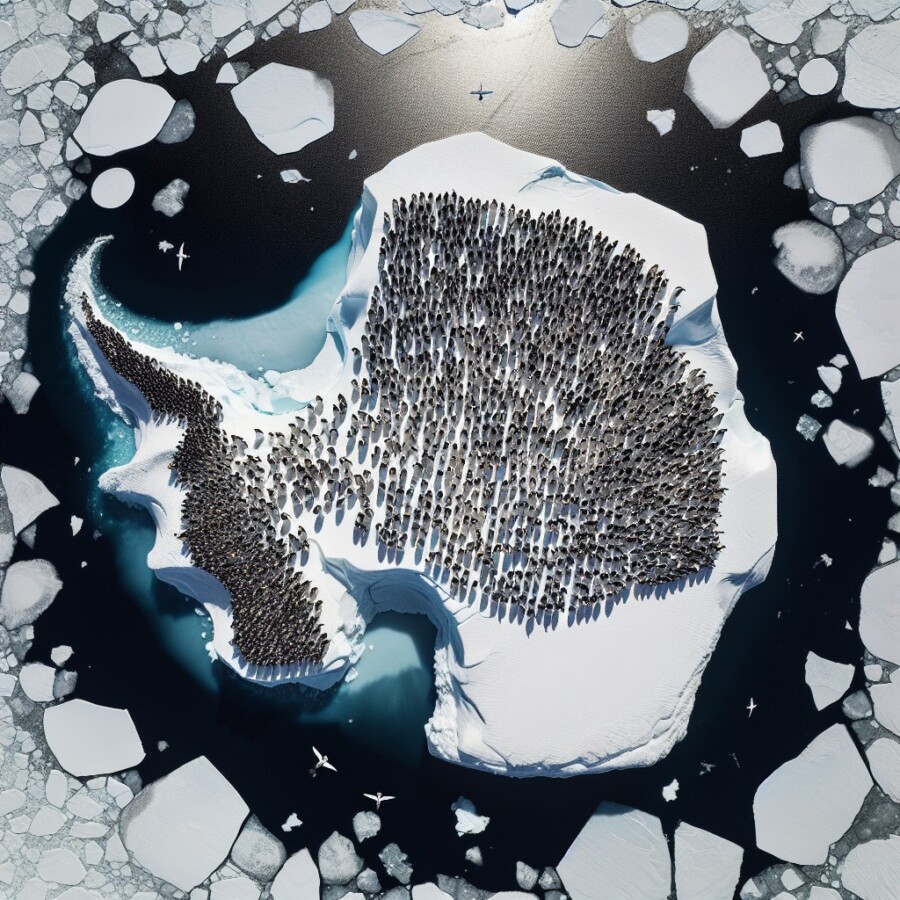Four new emperor penguin colonies have been discovered in Antarctica using satellite imagery, bringing the total number of known nesting sites to 66. This is important information for conservationists who are monitoring the species, as emperor penguins are facing increasing pressure due to climate change. These penguins breed and raise their young on fast ice, which has been diminishing and becoming more variable in recent years. The discovery of these new colonies is encouraging, but it also highlights the need for the penguins to be adaptable and move to new sites as ice conditions continue to change.
Emperor penguins are the largest species of penguin and live in extreme conditions in Antarctica. They breed in distinct groupings, with colonies separated by an average distance of 250km. Scientists have been using satellites to search for unknown colonies in the gaps between these groupings. The four new sites that have been found add a few thousand individuals to the estimated overall population of 550,000. It is clear that the penguins will have to be adaptable and move to new sites as ice conditions change, as evidenced by the shifting positions of some colonies.
Satellites have been the most effective tool for finding emperor penguin colonies due to the size and remoteness of Antarctica. The colonies are identified by the staining of their guano on the white ice, which can be visible even from space if there are enough penguins gathered in one place. Dr. Peter Fretwell from the British Antarctic Survey has identified about half of the known colonies using satellite imagery. The repeat imagery from the EU’s Sentinel-2 spacecraft has allowed scientists to monitor the attempts by emperors to establish a new colony near Britain’s Halley research station.
The discovery of these new emperor penguin colonies highlights the dynamic nature of the species. When ice losses occur in the future, the penguins have the ability to move and establish new nesting sites. Satellite tracking has provided insights into the distances the penguins travel to find food for their young, with adults traveling over 100km a day. The findings of these new colonies have been published in the journal Antarctic Science.
Original news source: Four new emperor penguin groups found by satellite (BBC)
🎧 Listen:
Slow
Normal
Fast
📖 Vocabulary:
| 1 | conservationists | Individuals dedicated to protecting natural resources and the environment |
| 2 | breeding | The process of producing offspring |
| 3 | diminishing | Becoming less or decreasing in size or amount |
| 4 | adaptable | Capable of adjusting to new conditions |
| 5 | satellites | Devices launched into orbit around Earth for various purposes, including observation |
| 6 | remoteness | The quality of being far away from population centers or hard to reach |
| 7 | guano | The excrement of seabirds, which is used as fertilizer |
| 8 | dynamic | Characterized by constant change, activity, or progress |
| 9 | insights | Understandings or interpretations gained from analysis or observation |
| 10 | staining | Marking or discoloring, especially in a way that indicates something’s presence |
| 11 | variability | The quality of being subject to change or fluctuation |
| 12 | imagery | Visual representations, especially those obtained by photographic or electronic means |
| 13 | pressures | Forces or factors that cause stress or strain |
| 14 | colonies | Groups or communities living in a specific location |
| 15 | monitoring | The act of observing and checking the progress or quality of something over time |
Group or Classroom Activities
Warm-up Activities:
– News Summary
Instructions: Have students read the article individually or in pairs. Then, ask them to write a summary of the article in their own words, highlighting the key points and main ideas. Afterward, have them share their summaries with the class and discuss any similarities or differences.
– Opinion Poll
Instructions: Divide the class into small groups. Assign each group a role, such as conservationists, scientists, or penguin experts. Ask each group to come up with a list of questions related to the article, such as “How can we mitigate the effects of climate change on emperor penguins?” or “What are the implications of finding new colonies?” Then, have groups conduct an opinion poll within the class, asking their questions and recording the responses. Finally, have each group present their findings and discuss the different opinions within the class.
– Word Association
Instructions: Write the word “penguin” on the board. Ask students to brainstorm as many words as they can that are related to penguins. Encourage them to think of nouns, adjectives, and verbs. After a few minutes, have students share their words and create a collective word association web on the board. Discuss the connections between the words and how they relate to the article.
– Sketch It
Instructions: Divide the class into pairs. One student will describe a scene or image from the article to their partner, who will then sketch what they hear. After a few minutes, have the pairs switch roles. Once both partners have had a chance to describe and sketch, have them share their drawings with the class and explain the scene they were trying to depict. Discuss the different interpretations and what aspects of the article stood out to them.
– Think-Pair-Share
Instructions: Pose a question related to the article, such as “What are the challenges that emperor penguins face due to climate change?” or “Why is it important to discover new colonies?” Give students a few minutes to think about their answer individually. Then, have them pair up with a partner and share their thoughts. Finally, open up the discussion to the whole class and have students share their ideas and engage in a group discussion.
🤔 Comprehension Questions:
1. How many new emperor penguin colonies have been discovered using satellite imagery?
2. Why is the discovery of these new colonies important for conservationists?
3. What is the main threat to emperor penguins due to climate change?
4. How do emperor penguins breed and raise their young?
5. How have scientists been using satellites to search for unknown colonies?
6. How do satellites help scientists identify emperor penguin colonies?
7. What has satellite tracking revealed about the distances emperor penguins travel to find food?
8. Where have the findings of these new colonies been published?
Go to answers ⇩
🎧✍️ Listen and Fill in the Gaps:
Four new (1)______ penguin colonies have been discovered in Antarctica (2)______ satellite imagery, bringing the (3)______ number of known nesting sites to 66. This is important information for conservationists who are monitoring the species, as emperor penguins are facing increasing pressure due to (4)______ change. These penguins breed and raise their young on fast ice, which has been diminishing and becoming more variable in recent years. The discovery of these new colonies is encouraging, but it also highlights the need for the penguins to be adaptable and move to new (5)______ as ice conditions continue to change.
Emperor penguins are the (6)______ species of penguin and live in extreme conditions in Antarctica. They breed in distinct (7)______, with colonies separated by an average distance of 250km. Scientists have been using satellites to search for unknown colonies in the gaps between these groupings. The four new sites that have been found add a few thousand individuals to the estimated (8)______ population of 550,000. It is clear that the penguins will have to be adaptable and move to new sites as ice conditions change, as evidenced by the shifting positions of some (9)______.
(10)______ have been the most effective tool for finding emperor penguin colonies due to the size and remoteness of Antarctica. The colonies are identified by the staining of their guano on the white ice, which can be visible even from space if there are enough penguins gathered in one place. Dr. Peter Fretwell from the British Antarctic (11)______ has identified about half of the known colonies using satellite imagery. The (12)______ imagery from the EU’s Sentinel-2 spacecraft has allowed scientists to monitor the attempts by emperors to establish a new (13)______ near Britain’s Halley research station.
The (14)______ of these new emperor penguin colonies highlights the dynamic nature of the species. When ice losses occur in the future, the penguins have the ability to move and establish new nesting sites. Satellite tracking has provided (15)______ into the distances the penguins travel to find food for their (16)______, with adults traveling over 100km a day. The findings of these new colonies have been published in the journal Antarctic Science.
Go to answers ⇩
💬 Discussion Questions:
Students can ask a partner these questions, or discuss them as a group.
1. What is the significance of discovering new emperor penguin colonies in Antarctica?
2. How would you feel if you were a conservationist monitoring the species and discovered new colonies?
3. Do you think climate change is the main reason why emperor penguins are facing increasing pressure?
4. Why do you think emperor penguins breed and raise their young on fast ice?
5. What do you think it means for the penguins to be adaptable and move to new sites as ice conditions change?
6. How would you feel if you had to live in extreme conditions like emperor penguins?
7. Do you like penguins? Why or why not?
8. What do you think it means for the penguins to be adaptable and move to new sites as ice conditions change?
9. How do you think satellites have been the most effective tool for finding emperor penguin colonies?
10. Why do you think the colonies are identified by the staining of their guano on the white ice?
11. How would you feel if you were a scientist using satellite imagery to search for unknown colonies in Antarctica?
12. Do you think it is important for scientists to monitor the attempts by emperors to establish new colonies?
13. Why do you think the discovery of these new emperor penguin colonies highlights the dynamic nature of the species?
14. How do you think satellite tracking has provided insights into the distances the penguins travel to find food for their young?
15. What do you think the future holds for emperor penguins as ice losses occur?
Individual Activities
📖💭 Vocabulary Meanings:
Match each word to its meaning.
Words:
1. conservationists
2. breeding
3. diminishing
4. adaptable
5. satellites
6. remoteness
7. guano
8. dynamic
9. insights
10. staining
11. variability
12. imagery
13. pressures
14. colonies
15. monitoring
Meanings:
(A) Characterized by constant change, activity, or progress
(B) The quality of being subject to change or fluctuation
(C) Devices launched into orbit around Earth for various purposes, including observation
(D) The process of producing offspring
(E) Understandings or interpretations gained from analysis or observation
(F) Individuals dedicated to protecting natural resources and the environment
(G) Marking or discoloring, especially in a way that indicates something’s presence
(H) Groups or communities living in a specific location
(I) Capable of adjusting to new conditions
(J) Visual representations, especially those obtained by photographic or electronic means
(K) The excrement of seabirds, which is used as fertilizer
(L) Forces or factors that cause stress or strain
(M) The quality of being far away from population centers or hard to reach
(N) The act of observing and checking the progress or quality of something over time
(O) Becoming less or decreasing in size or amount
Go to answers ⇩
🔡 Multiple Choice Questions:
1. How many new emperor penguin colonies have been discovered in Antarctica?
(a) Four
(b) Two
(c) Six
(d) Eight
2. Why is the discovery of new emperor penguin colonies important?
(a) It provides important information for conservationists
(b) It increases the overall population of emperor penguins
(c) It proves that emperor penguins are adaptable to changing ice conditions
(d) It allows scientists to study the guano staining on the ice
3. How many nesting sites for emperor penguins are now known?
(a) 50
(b) 66
(c) 100
(d) 75
4. What is the main threat to emperor penguins?
(a) Predators
(b) Loss of food sources
(c) Disease
(d) Climate change
5. How do scientists identify emperor penguin colonies using satellite imagery?
(a) By the size of the colonies
(b) By the distance between colonies
(c) By the staining of their guano on the ice
(d) By the color of the penguins’ feathers
6. How many emperor penguins are estimated to be in the overall population?
(a) 1 million
(b) 100,000
(c) 550,000
(d) 250,000
7. What tool has been the most effective for finding emperor penguin colonies?
(a) Drones
(b) Underwater cameras
(c) Field observations
(d) Satellites
8. What has satellite tracking revealed about emperor penguins?
(a) They stay close to their nesting sites
(b) They travel long distances to find food for their young
(c) They are not affected by changing ice conditions
(d) They do not migrate to new sites
Go to answers ⇩
🕵️ True or False Questions:
1. The staining of guano on the ice is not used to identify emperor penguin colonies from satellite imagery.
2. Emperor penguins breed and raise their young on fast ice, which has been diminishing in recent years.
3. The discovery of these new colonies highlights the need for penguins to be inflexible and stay at old sites as ice conditions change.
4. This keeps the total number of known emperor penguin nesting sites at 66.
5. Climate change is putting increasing pressure on emperor penguins.
6. Satellite imagery has been used to discover four new emperor penguin colonies in Antarctica.
7. Satellites have been an ineffective tool for finding emperor penguin colonies due to the size and remoteness of Antarctica.
8. Emperor penguins are the largest species of penguin and live in extreme conditions in Antarctica.
Go to answers ⇩
📝 Write a Summary:
Write a summary of this news article in two sentences.
Check your writing now with the best free AI for English writing!
Writing Questions:
Answer the following questions. Write as much as you can for each answer.
Check your answers with our free English writing assistant!
1. How many new emperor penguin colonies have been discovered in Antarctica?
2. Why is the discovery of these new colonies important for conservationists?
3. How do scientists use satellites to search for unknown penguin colonies?
4. What is the main tool used to find emperor penguin colonies?
5. What does the discovery of these new colonies reveal about the adaptability of emperor penguins?
✅ Answers
🤔✅ Comprehension Question Answers:
1. How many new emperor penguin colonies have been discovered using satellite imagery?
Four new emperor penguin colonies have been discovered using satellite imagery.
2. Why is the discovery of these new colonies important for conservationists?
The discovery of these new colonies is important for conservationists because it provides them with more information about the species and helps them monitor and protect the penguins, who are facing increasing pressure due to climate change.
3. What is the main threat to emperor penguins due to climate change?
The main threat to emperor penguins due to climate change is the diminishing and becoming more variable fast ice, which is where they breed and raise their young.
4. How do emperor penguins breed and raise their young?
Emperor penguins breed and raise their young on fast ice, which has been diminishing and becoming more variable in recent years.
5. How have scientists been using satellites to search for unknown colonies?
Scientists have been using satellites to search for unknown colonies by looking for staining of guano on the white ice, which can be visible from space if there are enough penguins gathered in one place.
6. How do satellites help scientists identify emperor penguin colonies?
Satellites help scientists identify emperor penguin colonies by providing imagery that shows the staining of guano on the white ice, which indicates the presence of a colony.
7. What has satellite tracking revealed about the distances emperor penguins travel to find food?
Satellite tracking has revealed that emperor penguins travel over 100km a day to find food for their young.
8. Where have the findings of these new colonies been published?
The findings of these new colonies have been published in the journal Antarctic Science.
Go back to questions ⇧
🎧✍️✅ Listen and Fill in the Gaps Answers:
(1) emperor
(2) using
(3) total
(4) climate
(5) sites
(6) largest
(7) groupings
(8) overall
(9) colonies
(10) Satellites
(11) Survey
(12) repeat
(13) colony
(14) discovery
(15) insights
(16) young
Go back to questions ⇧
📖💭✅ Vocabulary Meanings Answers:
1. conservationists
Answer: (F) Individuals dedicated to protecting natural resources and the environment
2. breeding
Answer: (D) The process of producing offspring
3. diminishing
Answer: (O) Becoming less or decreasing in size or amount
4. adaptable
Answer: (I) Capable of adjusting to new conditions
5. satellites
Answer: (C) Devices launched into orbit around Earth for various purposes, including observation
6. remoteness
Answer: (M) The quality of being far away from population centers or hard to reach
7. guano
Answer: (K) The excrement of seabirds, which is used as fertilizer
8. dynamic
Answer: (A) Characterized by constant change, activity, or progress
9. insights
Answer: (E) Understandings or interpretations gained from analysis or observation
10. staining
Answer: (G) Marking or discoloring, especially in a way that indicates something’s presence
11. variability
Answer: (B) The quality of being subject to change or fluctuation
12. imagery
Answer: (J) Visual representations, especially those obtained by photographic or electronic means
13. pressures
Answer: (L) Forces or factors that cause stress or strain
14. colonies
Answer: (H) Groups or communities living in a specific location
15. monitoring
Answer: (N) The act of observing and checking the progress or quality of something over time
Go back to questions ⇧
🔡✅ Multiple Choice Answers:
1. How many new emperor penguin colonies have been discovered in Antarctica?
Answer: (a) Four
2. Why is the discovery of new emperor penguin colonies important?
Answer: (a) It provides important information for conservationists
3. How many nesting sites for emperor penguins are now known?
Answer: (b) 66
4. What is the main threat to emperor penguins?
Answer: (d) Climate change
5. How do scientists identify emperor penguin colonies using satellite imagery?
Answer: (c) By the staining of their guano on the ice
6. How many emperor penguins are estimated to be in the overall population?
Answer: (c) 550,000
7. What tool has been the most effective for finding emperor penguin colonies?
Answer: (d) Satellites
8. What has satellite tracking revealed about emperor penguins?
Answer: (b) They travel long distances to find food for their young
Go back to questions ⇧
🕵️✅ True or False Answers:
1. The staining of guano on the ice is not used to identify emperor penguin colonies from satellite imagery. (Answer: False)
2. Emperor penguins breed and raise their young on fast ice, which has been diminishing in recent years. (Answer: True)
3. The discovery of these new colonies highlights the need for penguins to be inflexible and stay at old sites as ice conditions change. (Answer: False)
4. This keeps the total number of known emperor penguin nesting sites at 66. (Answer: False)
5. Climate change is putting increasing pressure on emperor penguins. (Answer: True)
6. Satellite imagery has been used to discover four new emperor penguin colonies in Antarctica. (Answer: True)
7. Satellites have been an ineffective tool for finding emperor penguin colonies due to the size and remoteness of Antarctica. (Answer: False)
8. Emperor penguins are the largest species of penguin and live in extreme conditions in Antarctica. (Answer: True)
Go back to questions ⇧













